
..........................................................................................................................................................................................................
has rule #12 had its day?

at one historical time in a road cyclist's life, there was really only the necessity to have two bicycles in the bike shed; one regular lugged steel road bike with the obligatory campagnolo groupset and a second fixed-gear machine for winter use in order to work on one's souplesse. to have any more than that would simply be classed as ostentation. after all, you can only ride one bike at a time anyway.
the latter is a mindset with which i was once in total agreement. there was a solitary steel colnago hanging on the workstand, a bicycle taken out every weekend in the vain hope that so doing would bring me closer to the abilities of the average professional (and we all know how well that worked out). however, almost without effort, that number has increased to the point where i was able to lend some carbon fibre to number one son without any serious diminution in cycling opportunity. i have two road bikes (one with mudguards), a cyclocross bicycle, a sit-up-and-beg three-speed roadster and quite frequently something bright and shiny in for review.
i have no shame in admitting that i couldn't ride fixed if i was paid.

however, aside from the machinery that permanently resides in thewashingmachinepost bike shed, a recently arrived 853 steel-framed pathfinder from dorset's sven cycles promises to potentially upset the carefully curated n+1 rule to which we all subscribe, even if we often pretend otherwise. though i have yet to undertake fully the review process for this machine, the company owner, sven coppin, made mention that he sees this type of bicycle to be the future of cycling.
outwardly, the pathfinder is no different from similar machines offered by many other cycle purveyors, including one or two of the so-called big boys, but i'm unaware of any who have commended this style of bicycle to be the possible solution to rule#12.
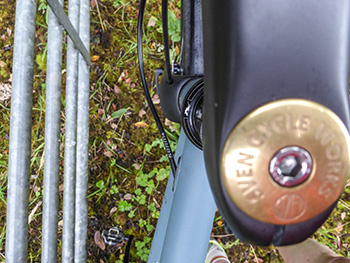
the pathfinder, in the guise received, is essentially what might be described as a gravel bike. it consists of a sturdy, yet lightweight tig-welded steel frame, beautifully understated in a blue/grey matt paint scheme, in this case, with a single ring chainset and a dinner-plate largest rear sprocket. featuring sram hydraulic disc brakes, the wheels are shod with 38mm rubber. those tyres are perhaps a tad smooth for mud and wet grass, but that leads me conveniently onto why i'm inclined to agree with mr coppin over his assertion concerning this style of bicycle.
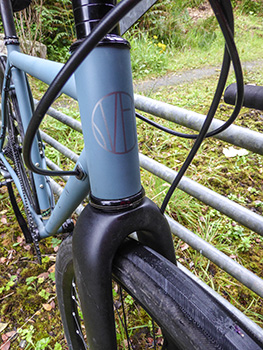
the overcrowded washingmachinepost bikeshed is also home to a pair of wheelsmith disc-equipped wheels, currently shod with 28mm road tyres. were i to acquire one more pair of wheels and fit them with a quality pair of 33mm cyclocross tyres, i'd surely have pretty much everything i'd need to reduce the hardware in the shed? granted, even with a choice of three wheelsets, i'd be hard pushed to beat tony martin in a time-trial or defend my king of the mountains jersey should i find myself alongside warren barguil.
but though most of us would like to think we could comfortably cope with either situation, realistically, how often is either scenario likely to occur in the average cycling week?
exactly.
in which case, in the face of ever more decrepit road surfaces and increasing motor traffic, wouldn't this be the ideal solution?
therefore, aside from the usual investigations that comprise a bike review, i have every intention of further assessing the pragmatism of sven coppin's not unreasonable assertion. let's face it; one bike and three sets of wheels is going to cost substantially less than owning three bicycles of similar quality. and perhaps means the need to own a smaller shed.
i'll get back to you in the fullness of time.
sven cycles pathfinder light | wheelsmith wheels
monday 21 august 2017
 ..........................................................................................................................................................................................................
..........................................................................................................................................................................................................the drive-in; maserati and cycling

a well-known motor company, responsible for providing mavic and others with their vehicles during the tour de france, screened a tv advert a few years ago depicting several gents carrying a wooden frame aboard which were a set of road bikes. as they ran past several cheering spectators at the roadside, we were informed that the tour would be quite different without them.
it's highly unlikely that any of the world tour teams would resort to such pedestrian tactics should this (for now) anonymous car manufacturer decide to spend its sponsorship monies elsewhere, but the advert made a salient point nonetheless.
many of the season's races have elicited comments on social media as to the seemingly ever-increasing number of vehicles surrounding a few blokes racing bicycles. it's always nice to feel we hold the moral high ground over sports such as formula one, international rallying and motorcycle racing, all of which consist of fossil fuel guzzling vehicles essentially going round in circles. the bicycle, as we are all well aware, utilises the more environmentally friendly propulsion of two legs and a pair of pedals. however, factor in all those official cars, team cars, police and camera motorcycles over the course of three weeks and suddenly the average grand prix looks positively green by comparison.
and yet the majority of cyclists are car owners or drivers. i've yet to read an interview with a well-remunerated cycling star who has cheerfully pointed to a double-garage full of state of the art carbon fibre. the more likely and common scenario is that of a porsche or audi (or both) filling each available space. this is perhaps less surprising than i'm trying to infer, for if you spend every waking hour riding a bicycle for a living, you're more than likely to drive the car to the supermarket or the cinema or the restaurant.
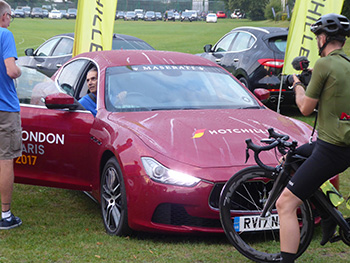
i'd be interested to learn just how many professionals have a folded brompton in the hallway.
so while the bike monthlies are often full of enticements to invoke rule #12, no matter what her/him indoors might think, the mamil has alerted one or two motor manufacturers that here might be a growing market waiting to be exploited. it is, as they say, the name of the game and one which has been put to excellent use by italy's maserati.
established in bologna in december 1914, maserati's stated mission was to 'build ultra-luxury performance automobiles with timeless Italian style, accommodating bespoke interiors, and effortless, signature sounding power.' though such a vehicle is conspicuous by its absence in the washingmachinepost driveway, i did recently have the opportunity to observe a couple of vehicles from the range at close quarters during the recent hotchillee london-paris ride, where the quattroporte and the ghibli featured as the lead cars for each of the five groups on the road. depending on specification, the ghibli offers a top speed of between 155-177mph and a 0-60 time of marginally over 6 seconds. quite what driving ahead of a peloton of cyclists at little over 30kph does to such a finely tuned engine and gearbox is anybody's guess.
peter denton's job title is maserati general manager, northern europe, making him undoubtedly the ideal person to enquire of what it was that brought one of the world's top luxury sports car manufacturers to become involved with cycling?
"Maserati came to cycling as we'd witnessed first-hand the development of interest in the sport and the sums that people were spending on their bikes and clothing. If cost was not an issue and style was important in this aspect of their lives, then style associated with the car they chose would probably also be important."

it's an assumption with which it is hard to argue. a quick cost approximation of all the items that featured on my saturday ride this weekend came perilously close to £6,500 (i hasten to add that the more expensive of these items were on review and not purchased from my meagre weekly allowance). suffice it to say, sums such as these are hardly unusual these days and if you factor in the n+1 rule, that amount multiplies quite quickly. pro-rata, an italian sports car starts to look like a more approachable proposition.
however, surely a more pragmatic solution would have been to involve a manufacturer of particularly speedy cars with the world of motor sport. unless, of course, cycling promises to be a more cost effective means of promotion than the latter?
"We are choosing to engage with amateur cycling, which is very cost effective and allows us to spend quality time with the audience to explain the Maserati range, its price point and relevance to the audience. This is especially true with a £56,250 SUV in our range."
i confess that i'd missed the now glaringly obvious point made by mr denton, that maserati had eschewed placing its vehicles within the professional peloton, preferring instead to appeal to those of us who ride purely for the fun of it. it's highly unlikely that a.s.o. would be overly impressed by the sight of peter denton standing on the champs elysées podium, extolling the virtues of the maserati range. which then beggars the question as to where former professional david millar fits into the equation?
"David Millar extends our connection to cycling. As a Maserati enthusiast, an experienced and successful former pro cyclist and an eloquent and engaging individual, he helps to tell our story to a audience that enjoys listening to him."
it is a well-made point, for how many of us have purchased the bicycles we have in the bike shed on the basis that our heroes ride the same brand? since his retirement from the professional milieu, millar has formed an enduring, if seemingly implausible commentary partnership with ned boulting, offering an accurate, matter of fact approach to the sport. it seems logical to assume that this personal approach would extend to any matters in which he becomes involved.
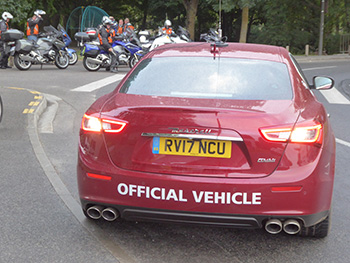
cycling was, at one time, viewed as a working man's sport, a viable and more lucrative alternative to working down the mines or in the fields. though this would hardly be seen as applicable to the amateur, until recently, recreational cycling would hardly have been discussed in the same breath as cricket, golf or rugby. but with the bradley bubble allegedly encouraging the growth of the ubiquitous 'middle aged men in lycra' things have changed somewhat. riding the hotchillee london-paris event costs a basic £1500. with spending money, bike repatriation and eurostar return taken into account, you'd be looking at an outlay of approximately £2000 for three days in july. and one of the post-tour finish packages would have lightened your bank balance to the tune of around £5,600.
i therefore asked mr denton if the recent encapsulation of cycling as the 'new golf' meant that road cyclists are now perceived to have the income to afford a maserati?
"I probably answered that in my first response. However, in real terms, the growth of interest (in cycling) gives us a huge audience to engage with and support through our involvement, many of whom can afford our cars. They are just not aware that Maserati is so affordable. Until cycling allowed us to tell them."
a swift maserati dealership check informs that the basic maserati ghibli (a three-litre v6 diesel) retails at £49,620, rising to almost £65,000 for the s model. many of you, self included, might think mr denton's definition of affordable is one you've rarely come across before. however, while my assertions are based almost entirely on conjecture, i'd be very surprised if maserati's promotional strategy were subject to the same flimsy approximation.
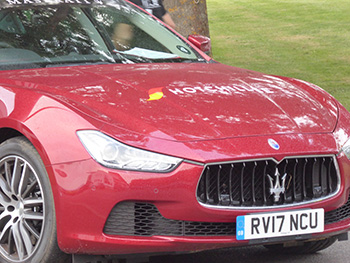
it is, however, an undeniable aspect of the majority of sponsorship deals, that ultimately the gains will suffer from the law of diminishing returns and the moving finger, having sponsored, will move on. maserati's involvement with cycling is still in its early days, but did they have a fixed period in mind for their two-wheeled relationship, or is it open-ended?
"For as long as there is value in our involvement there is reason to continue. Value comes from a positive response to our involvement."
the impetus for this feature was a genuine desire on my part to understand why a luxury sports car manufacturer would opt for an association with cycling as opposed to what might be regarded as a more traditional (and safer?) preaching to the arguably more converted motoring public. i appreciate that, unless you're me, it's perfectly acceptable to be seen as both a cyclist and a motorist; in fact it's probably the more common stance. however, maserati stepping out of their comfort zone to target a less predictable audience is one that should probably be applauded, something that few, if any, cycle manufacturers seem keen to follow.
does peter denton think that more cycling firms could benefit by turning the tables and advertising more directly to motorists?
"I don't know that advertising to motorists by cycle companies would be as effective. Cycling is largely social and therefore by adding value to cycling, Maserati can resonate in that space; I am not sure if it would work in reverse!"
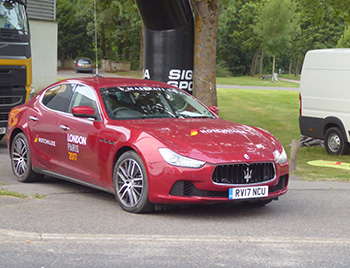
if you, like me, found it all but impossible to find the entrance to london's victoria house for last november's rouleur classic, gesticulating wildly to some bemused folks standing behind a maserati or two, while trying vainly to open locked glass doors, you'd likely have grasped that the event is also one sponsored by the italian cars. while timorously debating whether to ask if my name was on the guest list or not, it was hard to avoid the sleek cars parked adjacent to the entrance, garnering admiring glances from those in the queue.
along with my original inquisitiveness as to the maserati/cycling tie-in with hotchillee events as well as ride london, it also seemed an odd conjunction between a dyed-in-the-wool road cycling magazine and very fast italiana. presumably, however, maserati have been pleased with their association with the annual rouleur classic?
"Maserati has a good relationship with Rouleur and both enjoys and benefits from the link to the Classic, now in its third year of association."
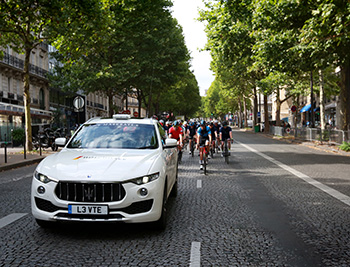
i confess i'm still slightly mystified by but appreciative of this particular association, but there's little denying that it says as much about the current status of road cycling as it does about maserati. no doubt there are those who think that it sullies the purity of the sport/activity, but as i mentioned in my opening paragraph, many aspects would be a whole lot different if motor cars were conspicuous by their absence from the peloton. and my vehicular agnosticism notwithstanding (i can drive, i just choose not to), it was still pretty cool riding to paris behind a metallic burgundy maserati ghibli, even if it was only driving at 25kph.
sunday 20 august 2017
 ..........................................................................................................................................................................................................
..........................................................................................................................................................................................................maurad bike storage
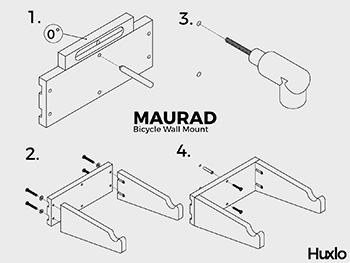
not that far from washingmachinepost croft, on the other side of bowmore distillery's bonded warehouses, the local housing association has built a number of new homes, predominantly one and two bedroom dwellings to accommodate those who have previously found the latter hard, if not impossible to acquire. they have now embarked on building a number of larger houses, now that the individual market has been all but hoovered up, leading to a more substantial development the major downside of which is the gaelic street names.
do not misunderstand me, i have no real gripe with gaelic, but few of the incumbents are gaelic speakers, making it probably highly entertaining for those working in call-centres and mail order catalogues. i should imagine the majority have already resorted to spelling everything to ensure accurate delivery. however, in keeping with the majority of new house building in rural areas, the overarching concern from the associations' point of view is that of economy. very roughly translated, you could fit the entire development into a single bedroom in buckingham palace.
well, maybe.
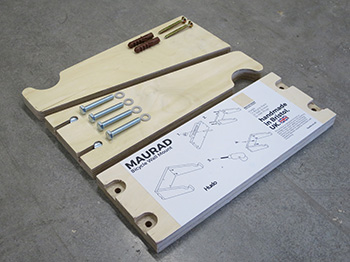
that will undoubtedly and eventually lead to space problems when personal acquisitions outgrow the storage available. i know we've all been there; the croft, despite having once been home to two teenagers, is now beginning to burst at the seems, either with a vast selection of children's toys (for those in the charge of mrs washingmachinepost) or an ever increasing array of percussion instruments on my behalf. it is, i believe, the modern way. and though the croft could hardly be compared to the average mansion, the newer houses offer even less in the way of liebensraum. there's scarcely room to swing a cymbal stand.
one of the sunday morning peloton lives in a new upper floor flat, in the all but unpronounceable street. in order to store his bicycles, he has occupied a substantial portion of his compact and bijou rear garden area with a shed. however, thought he has two young children, if life follows a standard meme, when they leave home, he's going to find himself with less space than he ever though possible. and the relief on his income will surely allow him the luxury of invoking rule #12 which will provide him with the storage problem i think i mentioned above.
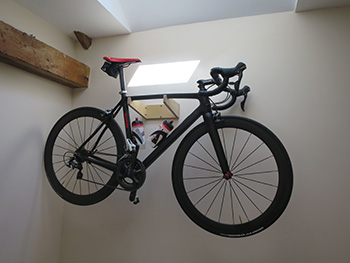
it is, for even the modest velocipedinist the perennial problem. for how can one adhere to velominati's rules when there is seemingly nowhere to put all those bicycles? this anticipated or currently real situation is one that has apparently inflicted itself upon the fellows at bristol's huxlo, designers and builders of digitally created wood huts and the like. in order to satisfactorily rid themselves of velocipedinal clutter, they have produced the maurad bicycle storage system, one that adheres to the maxim that simplest is often best.
there have been several successful attempts to allow the hanging of bicycles from the sitting room, hall or even bathroom wall, but the maurad differentiates itself from the competition by utilising sustainably sourced timber from fsc certified forests and its admirable simplicity. yet again, the production of items such as the maurad will cost money and in order to crowdfund the sum required, huxlo have engaged the services of indiegogo to which you are cordially invited to visit. if this particular bike storage system is one with which you find yourselves in accord, a few pounds will bring bike-hanging such as this to fruition. you know the drill.
saturday 19 august 2017
 ..........................................................................................................................................................................................................
..........................................................................................................................................................................................................proselytisation

there may be one or two of you involved in the marketing of bicycles and related items who have had need of perusing a media-pack on offer from the bona-fide cycling publications. for those who could care less, these inform potential advertisers as to the circulation figures of the magazine along with advertising costs and preferred formats in which any advertisement ought to be submitted. as with the majority of publications in any particular field, there are often discounts on offer if you're willing to book and pay for a sequence of advertisements, an economical way to do business if you'd like to keep that trademark in the eye of the cycling public.
as an example, placing a full page advertisement in the comic for twelve issues as opposed to a single edition, can save over £200 per advert. decide to fill that same page for an entire year and your bank balance will be healthier to the tune of around £400 per issue. as the saying goes, "you pays your money, you takes your choice.".
there are one or two notable examples of cycle-related companies, purveyors of desirable apparel or componentry who have become rather successful despite a deliberate choice to eschew any form of concerted print advertising campaign whatsoever, but they are in the distinct minority. the majority of manufacturers or retailers depend considerably on getting their message across via cmyk, frequently augmenting this with a companion online advertising campaign.
the hidden benefit of the latter, rests with the data tracking procedures that are now de rigeur. who amongst us hasn't visited a website totally unrelated to cycling, only to view an ad for the very online retailer from which an item was ordered the night before? sir martin sorrell's alleged £70 million annual salary and his net worth of £495 million as ceo of advertising agency wpp, if nothing else, can be seen as a notable indicator of his company's annual revenue. if they can pay him all those millions, consider what the company's profit margin must be.
while i'd be more than happy to accrue that sort of advertising revenue from the banner ads on the post, we both know that's never ging to happen unless google find themselves in desperate need of a cycling blog. however, one of the fringe benefits of having written the post for oh, so many years, is that every now and again, people ask you stuff. questions such as why i started in the first place, what my all-time favourite bike is and most recently, what i'd say to a non-cyclist to convince them it's great.
thankfully, this wasn't one of those on-the-spot queries, where you end up mumbling something hopelessly irrelevant and only thinking of something really, really clever when the opportunity has passed. in this case, i had an afternoon to form my highly cogent answer which, since you ask, was 'take them for a bike ride'. and though i've had a day or two to consider my answer further, i'm pretty sure i wouldn't change it even if i had another twelve months.
though there's a danger of wearing it as a badge, i may have mentioned on more than one occasion, that i do not own a mobile phone. many an individual, besotted with their own apple or samsung, has attempted to persuade me of the benefits to be had from smartphone ownership, few, if any, of which seemed beneficial to yours truly. and though being surrounded by inveterate phone users has had no detectable effect, i'm firmly of the opinion that the best way of advertising anything to anyone is by example.
to quote il campionissimo, fausto coppi; ride your bike, ride your bike, ride your bike.
friday 18 august 2017
 ..........................................................................................................................................................................................................
..........................................................................................................................................................................................................getting very cross indeed

though guys like tom ritchey, joe breeze and gary fisher are alleged to be amongst the unwitting inventors of the mountain bike, by throwing themselves down the repack run on mount tamalpais in california, those of us besotted by bendy bars and somewhat narrower tyres are (or should be) aware that traversing the great untrammeled outdoors on a bicycle precedes this 1980s cycling revolution by quite a number of decades.
while archaeologists have catalogued and verified entire portions of history and pre-history, from the big bang onwards, it seems that the precise origins of cyclocross are largely unknown. however, the likely opening scenario rests mostly on european road racers in the early 20th century challenging each other to race from one village to the next, making use of any number of shortcuts across intervening farmland and/or metalled roads, whichever appeared to offer the quickets means of reaching a not always clearly defined finish line.
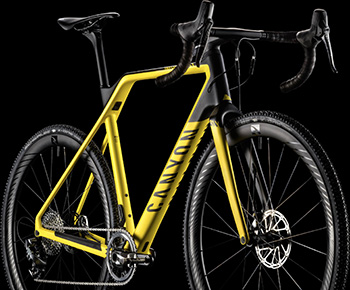
in the days when the road racing season, such as it was, confined itself to a far shorter period than is currently the case, racing through the winter months in this most rugged of fashions offered two bonuses. firstly, it kept those gents fit and healthy through the off-season and secondly, due to a regularly inclement north european winter climate, it toughened them to a degree that sitting at home drinking alarmingly poor coffee simply wouldn't. after the 1910 tour de france winner, octave lapize, attributed his success to riding 'cross in the off-season, the sport spread further afield (if you'll pardon the pun).
the modern day cyclocross parcours, though emulating several features of the original idea, are, in effect, somewhat sanitised and a darned sight more repetitive than their forebears. if you've ever taken the opportunity to venture from one rural village to another by the shortest cross-country route, you will be aware that the terrain is less than uniform. were i to attempt this very activity from bowmore to bridgend, avoiding the main road, a particularly boggy, wet and difficult ride awaits me. and though i look forward to each year's cyclocross season as much as the next man or woman, i'm too much of a wimp to put the specialized crux through such (dis)agreeable adversity.

throughout the bulk of cyclocross history, bicycles design has varied little. until the 1990s, most have been constructed from lugged steel, and though early 'cross champions rode on wooden rims, it wasn't long before the bicycles closely resembled their road going brethren but with a tad more mud clearance, knobblier tyres and eventually cantilever brakes.
technology in all areas of modern life has encroached upon us at an accelerated rate, leaving scarcely anything, including the cyclocross bicycle, untouched. carbon is now de rigeur, despite early misgivings over the robustness of the material. gone too are the cantilever brakes, almost entirely replaced with hydraulic discs, though as framebuilder and 'cross racer, richard sachs once pointed out, braking power depends greatly on the grip offered by tyres and surface underfoot. electronica has made its expected inroads and latterly, sram have dispensed with one of the chainrings in favour of wider-range derailleurs and remarkably large sprockets at the rear.
one of the salient features of cyclocross, however, one that differentiates the sport from either road cycling or mountain biking, is the occasional need to shoulder the bicycle when encountering hurdles or steep, muddy inclines. historically, this probably meant suffering from a painful right shoulder every monday morning. the advent of carbon offered a material that can be seemingly shaped to suit any and all occasions, including approximating the profile of the average human shoulder. colnago notably featured a curved tube on their prestige model, between the top and down tubes, ridden to superb effect by the now retired sven nys.
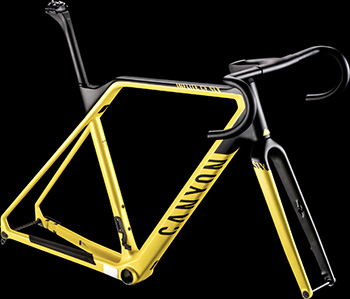
however, whatever your opinion on the aesthetics of ernesto colnago's frame designs, they have surely been bolstered by the recent release by canyon bikes of the snappily named inflite cf slx just ahead of this year's 'cross season. alternatively named on twitter as including either the shoulder garage or clavicle shed, it would be hard to argue that canyon's fashioning of the seatpost region is anywhere near attractive. nor, indeed, is there any evidence that its purported function was requested or desired.
according to canyon, this re-arranging of the seatstay, seat tube and top tube junction exposes more seatpost to the atmosphere, thus allowing more flexibility to improve rider comfort.
long-term observers of bicycle design may recall the mike burrows designed giant tcr, possibly the first of the now ubiquitous sloping top tube designs. in order to minimise the high costs associated with carbon monocoque molds, giant took the decision to produce three sizes: small, medium and large. adapting those to differing sizes of rider was achieved by means of an alarmingly long seatpost. however, if memory serves, giant's copywriters alleged that the shortness of seat tube would lead to improved stiffness, avoiding entirely the seemingly obvious observation that a longer, unsupported seatpost would surely negate every gain made lower down.
contradiction is the new black.
i have not ridden one of canyon's new 'cross bicycles, so i can only infer from the images i've seen that their eccentric frame design appears to offer little in the way of comfort enhancement. i could be entirely wrong, but once more, cycling seems intent on providing solutions in desperate need of corresponding problems.
thursday 17 august 2017
 ..........................................................................................................................................................................................................
..........................................................................................................................................................................................................just when you were looking the other way
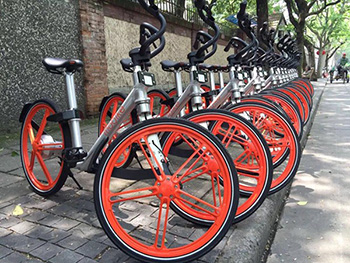
in a recent guardian article, helen pidd decried the opening days of the latest dockless bike hire scheme that landed in manchester at the end of june this year. while the boris bikes in london and similar schemes elsewhere require to be placed into strategically, but not always conveniently placed docking stations, mobike purported to revolutionise the propitiousness of random bike hire by dispensing with the dock entirely. though the chinese company's bicycles, with proprietary parts that are difficult to dismantle, shaft-driven transmission and magnesium alloy wheels are fitted with allegedly unbreakable wheel locks, the manchester environment has apparently failed to equal their aspirations.
ms pidd described bicycles being dragged from the canal and many being misappropriated by individuals for their own private use, having figured out how to bypass the gps location technology and wheel locks in mere minutes. the guardian's north of england editor reported confronting an individual who had stowed a mobike in his shed; on pointing out that she wished to use the supposedly available bicycle, the gent ignored her please stating that he had need of using it later in the day himself.
the system is supposed to work by advising potential users via a mobile phone app as to the location of bicycles within accessible distance. this is does via gps. on payment via that selfsame app, a generated code allows unlocking of the bike which can then be ridden to any desired location and left somewhere appropriate at journey's end. you and i could doubtless see the downsides of the system prior to its installation, for there are few cities or large towns in the united kingdom where leaving unattended bicycles alone for any time, does not equate to an invitation to steal. more especially if there's a degree of ingenuity required so to do.
but what if hiring bicycles is what might be referred to as a red herring? what if a mobike is simply a means to an end, in a manner other than you and i would describe it? let's face it, though the chinese parent company might be a tad naive when it comes to the social mores of britain's inner-cities in the second decade of the 21st century, it's hard to believe that similar anti-social activities such as those described above, do not also take place in china; human nature is human nature no matter the language spoken.
around the time that mobike was installing its bicycles on manchester's streets, online behemoth amazon was announced as about to purchase whole foods market for a reputed $13.7 billion. whole foods consists of brick and mortar stores, giving rise to queries as to why a wholly successful online business would want to move into out of town retail? however, amazon is a tad smarter than that; the data they can garner from customers ordering online before stepping into their local whole foods store to collect, will help them track purchasing behaviour of millions, allowing them to better inform themselves as to what other items they might suggest at point of online purchase.
disbelief that for mobike, it's not all about the bike, would be more comprehensible if bicycle hire was not the real reason for the operation. it's scarcely a national secret anymore that mobile phone use generates a substantial amount of data extraneous to the core purpose of any specified app. data that amazon, facebook, google and indeed, apple are more than happy to acquire, analyse and subsequently monetise in their favour. for in order to pay for a potential mobike hire, that app has to connect to credit card details, generating payment habits that third party investors are quite literally banking on to make them a lot of money. and it's just possible that it is this information that's the real business plan. though allegedly state of the art, the mobike might simply be an expendable technological diversion.
you didn't think strava was actually interested in your k.o.m. uploads?
wednesday 16 august 2017
 ..........................................................................................................................................................................................................
..........................................................................................................................................................................................................chasing the rainbow. the story of road cycling's world championship. giles belbin. aurum press hardback. illus. 303pp £20

if i were actually interested, it would be interesting to survey the world's various professional sporting activities to ascertain just how their governing bodies attempt to select an annual champion from amongst the more prolific or successful (or both) participants. formula one motor sport, in company with its lesser siblings, seems content to see how its combatives fare over the course of a year, by way of costing them a fortune to travel to all manner of unlikely countries and their pristine race circuits.
i am insufficiently well-acquainted with the minutiae of motor sport to know whether there is an upper limit on the number of teams allowed to partake of the average grand prix series, but i dare say there are only so many teams of two cars that can be safely fitted on even the most extensive racing circuit. however, the world champion in flameproof overalls receives his annual accolades by way of accumulated points throughout the season, a situation that cycling's overlords in aigle have allegedly attempted to emulate with the current world tour series.
however, though it may well be possible to appoint a world champion in this manner, a touch of randomness is inherent in such a system. though the rules and regulations of the world tour demand that the 18 designated first division teams have no option but to participate in each race, there is no sub-section that indicates each team must consist of the same riders. ever willing to offer the benefit of the doubt, the iniquities of cycle-racing means different races suit some riders better than others. paris-roubaix might be the equivalent of tom boonen's sitting room and not chris froome's, but rare are the occasions when the former has led across the finish-line atop the galibier.
i seriously doubt that a formula one ferrari is quite so fickle.
thus, professional (and amateur) cycling chooses the wearer of its rainbow bands by way of an annual one-day race across a wide-range of circuits worldwide. the downside to this situation is the date of this yearly event; several of the world's finest competitors frequently decide to give it a miss, either for reasons of a hard preceding season or because the parcours does not suit their professed strengths. and is it just me, or have more recent world championships seemed more to suit the sprinting fraternity than those with grimpeur on their business cards?
either way, the annual cycling world championships, both male and female, restrict victory and its associated plaudits to a single day, with competition featuring national teams rather than the rest of the season's trade teams. in the age of increasing salary demands, can you see the potential problems?
author giles belbin has written a comprehensive history of the world championships, from their professional inception at germany's nurburgring motor race circuit in 1927, to (oddly enough) the opening chapter, where belbin's narrative centres around last year's controversial race in the sweltering climate of doha. that first event in 1927 was sanctioned by the uci, allowing both pros and amateurs to mix it up in germany, minus a french contingent who deemed the race surplus to seasonal requirements and hardly the ideal way to choose a champion.
1927 was an entirely italian affair, with the french domiciled alfredo binda demonstrably wresting victory from the original campionissimo, costante girardengo.
"Once he had attacked no-one could go with him and in the space of 6 kilometres Binda opened a gap of more than two minutes. The race was over. Binda's winning margin over Girardengo was more than seven minutes."
belbin's opening chapter celebrates a second straight win for peter sagan, partially recounted on page 242. in between, it is posisble to relive, at varying length, every intervening world championship race, including the women's world championship events since their introduction in reims, france in 1958. were you to helpfully point out that this surely would struggle to fulfil the requirements for an interesting read, i would, initially, have tended to agree with you. however, i have so far failed to mention chasing the rainbow's unique selling point: interviews.
commencing by way of a superb interview with the grandson of 1938 winner marcel kint, belbin has spoken with other luminaries such as barry hoban, nicole cooke ("We were doing ridiculous things in training and going on the course at silly times."), felice gimondi, keetie van oosten-hage and even stephen roche ("British Cycling wasn't what it is now. [...] you had to give the jerseys back - washed.") amongst others.
from my point of view, it's these interviews that shine brighter than the recounting of each race for the rainbow jersey. at the culmination of the book, there's a brief discussion of the world's time-trial event seguing into a comprehensive listing of the first three places for each elite men's world championship race, elite women's and time-trial results. the heavy-lifting at the back of the book is further enhanced with footnotes to accompany each chapter plus a comprehensive index, affording flakey media types such as myself, the ability to impress you with our faux knowledge of the rainbow jersey well into the future.
there's no real denying that the annual quest for a rainbow jersey is a continued expression of cycle-racing's professed eccentricity, but it is no less exciting for all that. belbin's well-paced and researched history of the event is every bit as inviting, with enough time to read cover to cover before this year's race begins in bergen on sunday 24 september.
chasing the rainbow by giles belbin is published by aurum press on wednesday 16 august.
tuesday 15 august 2017
 ..........................................................................................................................................................................................................
..........................................................................................................................................................................................................